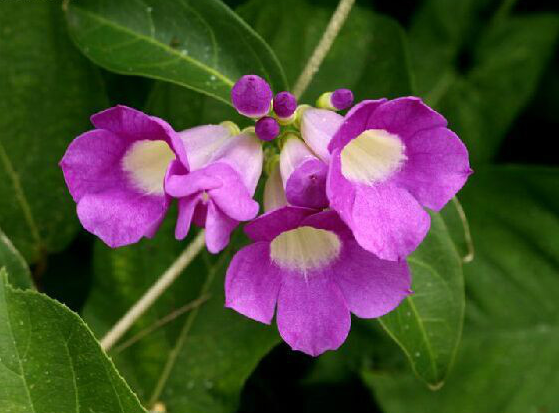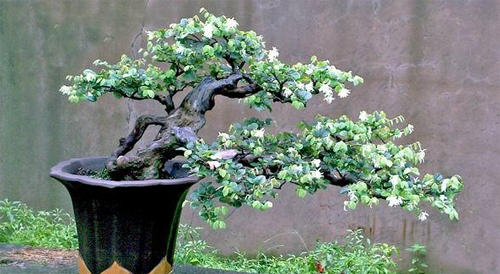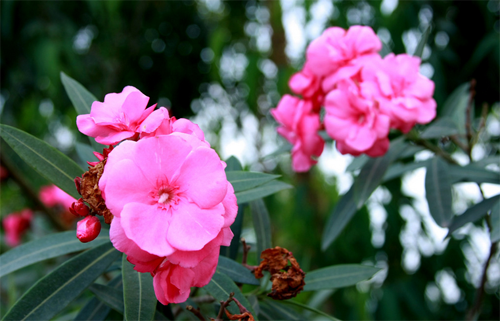The cultivation method and reproduction of garlic vine do you want to lose the leaves in winter?
Garlic vine is not generally good-looking, but also can climb the wall, garlic vine flowers are also particularly good-looking, just like a blossom of small trumpet flowers, what are the breeding methods of garlic vine? How do you reproduce? Do you want to lose the leaves in winter?

The culture method of garlic vine:
1. Light and temperature
Garlic vine likes light and warm climate, the water and fertilizer should be sufficient in the growing season, and the suitable temperature for growth is 18-35 ℃. Some leaves will fall when the winter temperature is below 5 ℃, but it can also survive the winter safely.
Be sure to plant it in a place with plenty of light, otherwise it will blossom sparsely or not, and the environment of full sunshine is the best.
2. Soil
It has no requirements for soil quality, potted plants, ground plants, climbing vine growth, of course, we need to pull its growth, every spring after flowering for pruning.
Spring and summer is its peak growth period, the growth stops at low temperature in winter, and the watering is reduced in winter.
Notes on garlic vines:
Garlic vine flowers, leaves after kneading, there will be a strong smell of garlic, flower friends do not like it?
It has tendrils and swollen nodes, opposite leaves, dark green leaves and green back.
It has many and colorful flowers, and the Corolla is funnel-shaped, usually pink and purple, with flowers in full bloom.
Looking at the flowers, I really didn't think it could replace garlic as a seasoning in the kitchen.
We can put it in a place with enough light, but it is a pity that it is not cold-resistant, and the cold wind will affect its growth.
It is best planted in sunny leeward, loose, fertile slightly acidic sandy soil.
Flower friends in the north can be potted, and the soil can be mixed with garden soil, sawdust and peat soil at 1:1:1: 1, as cultivation soil.
The propagation method of garlic vine:
Garlic vines can be propagated by sowing, cutting or striping. Generally speaking, cuttings are the main.
The suitable period of cutting is in spring, summer and autumn, and it is the best from March to July.
When cutting, cut the mature branches, the length of each cuttage is about 15cm, cut off the lower part of the cuttings with 3 leaves, keep the upper leaves, and the cut in the lower part of the cuttings should be close to the lower part of the node. The medium can be perlite or moist river sand.
The cutting depth is that the branches do not fall down, and the density is not squeezed or touched by the leaves, so as to ensure the air permeability of the roots, the ventilation of the leaves and good light. According to the conventional management, it can take root in about 3-4 weeks, and the rooting rate can reach more than 85%.
About 7 weeks after the root system is fully developed, it can be transplanted.
The flowering period of garlic vine:
The leaves have the smell of garlic and can blossom in a year at a suitable temperature. The most flowering is in autumn and winter (September to December), sometimes twice a year.
Will garlic vines lose their leaves in winter?
Garlic vines will not lose leaves in winter, after the flowers withered, the leaves are still very green, you can rest assured to breed.
This is the end of the introduction on the planting methods and matters needing attention of garlic vines. Why not raise such a naughty plant as soon as possible.
Pseudocalymma alliaceum Sandw. Garlic vine picture: how to raise garlic vine / how to reproduce garlic vine famous piece garlic vine Pseudocalymma alliaceum Sandw. Introduction to the cultivation methods and matters needing attention of garlic vines when garlic vines are in full bloom, they seem to be hung with pink hydrangeas, which are climbing plants of great ornamental value, and are strong in nature, showing few diseases and insect pests, and are suitable for growing into flower corridors, or climb on flower racks, walls and fences. Garlic vine, also known as Zhang's crape myrtle, purple bell rattan, is an evergreen climbing shrub, native to the West Indies to Argentina. Garlic vine is a species of Liriodendron, whose flowers are purple and are mostly used as ornamental plants in horticulture, with winged fruit. The leaves of garlic vines have the taste of garlic, hence the name. Taiwan blossoms sporadically throughout the year, but the flowering period of the whole plant is about autumn and winter (September to December), but sometimes it blooms twice a year. Morphological characteristics of garlic vine garlic vine is an evergreen climbing shrub, compound leaves opposite, 2 leaflets, tendrils 1 or absent, leaflets 6-10 cm long and 2-5 cm wide, oval, apex pointed. Inflorescences, axillary, large flowers, lavender, flowers and leaves have the smell of garlic. It is suitable for flower gallery, flower rack, hedge wall or shade shed beautification. Garlic vine is native to tropical America. Plant trailing, tendril, leaves for two compound leaves, dark green oval, glossy. Flowers axillary, Cymes, Corolla tubular, opening 5-lobed. The flower is pink-purple when it blossoms, and then slowly turns into pink, and then becomes white and then falls. The flowering period is from spring to autumn, but spring and autumn are in full bloom. Because the flowers and leaves are rubbed with the smell of garlic, it is named garlic vine. Compound leaves opposite, 2 leaflets, tendrils 1 or absent, leaflets 6-10 cm long and 2-5 cm wide, elliptic, apex pointed. Agglomerate inflorescences, axillary, large flowers, lavender, flowers and leaves have the smell of garlic. It is suitable for flower gallery, flower rack, hedge wall or shade shed beautification. The ecological habits of garlic vines garlic vines like light, like warm and hot climate, and there should be sufficient water and fertilizer in the growing season. Garlic vine likes the warm and humid climate and sunny environment, and the suitable temperature for growth is 18-35 ℃. When the winter temperature is below 5 ℃ for a short time, the subtropical area can survive the winter safely except some fallen leaves. Garlic vines are suitable for both pot and ground planting, regardless of soil quality. The cultivation site must have enough light, otherwise the flowering is sparse or not, and the all-sunshine environment is the best. Due to the trailing nature of the plant, if it is allowed to stretch freely, the branches are easy to show clutter, so it is suggested that pruning can be carried out after blooming in spring every year. Sex likes high temperature, and the suitable temperature for growth is about 21-28 ℃. Spring and summer is the period of vigorous growth, and low temperature in winter will stop growing, so watering in winter needs to be reduced. Cultivation techniques of garlic vines garlic vines are suitable for both pot and ground planting, regardless of soil quality. The cultivation site must have enough light, otherwise the flowering is sparse or not, and the all-sunshine environment is the best. Due to the trailing nature of the plant, if it is allowed to stretch freely, the branches are easy to show clutter, so it is suggested that pruning can be carried out after blooming in spring every year. Garlic vine is fond of high temperature, and the suitable temperature for growth is about 21-28 ℃. Spring and summer is the period of vigorous growth, and low temperature in winter will stop growing, so watering in winter needs to be reduced. The cultivation method of garlic vine the garlic vine is a perennial evergreen vine of the Liriodendron family. After rubbing the flowers and leaves, they will have a strong garlic flavor, hence the name. With tendrils and swollen nodes, leaves opposite, elliptic, entire, dark green, abaxially green. Flowers many and dense, Cymes axillary or terminal, Corolla funnelform, apex 5-lobed, pink or pink-purple, flowers in full bloom. The flowering period is throughout the year, and it can blossom many times a year, usually in late summer and early autumn from September to October. Shuo fruit flat, long linear. Ecological adaptability garlic vine is native to Guyana and Brazil in South America. Sex prefers warm and humid climate and sunny environment, the suitable temperature for growth is 18-28 ℃, the subtropical area can survive the winter safely except some fallen leaves when the winter temperature is lower than 5 ℃ for a short time, and freezing injury can be caused in the aboveground part when the temperature is below 5 ℃ for a long time. It needs to be cultivated all day long. Cultivation and management of garlic rattan cultivation requires sufficient light and warm climate, is not resistant to cold, long-term cold wind blowing will affect growth. Generally planted in the sunny leeward, loose, fertile slightly acidic sandy loam. Open field cultivation only needs watering when it is dry in summer. Potted plants are watered once a day in summer and every 3-4 days in winter. Garlic vines prefer natural organic fertilizer, so they can apply rotten fertilizer in the planting hole and apply nitrogen, phosphorus and potassium compound fertilizer once a month after maturity. The site with good drainage should be selected for open field cultivation. Pot soil can choose garden soil, sawdust and peat soil to mix cultivation soil. Because the flowers and leaves have strong garlic flavor, insects refuse to eat, and no obvious diseases and insect pests have been found in cultivation. Propagation method garlic vine can be propagated by sowing, cutting or striping. Generally speaking, cuttage is the main production. The suitable period for cutting is spring, summer and autumn, especially from March to July. When cutting, cut the mature branches, the length of each cuttage is about 15cm, cut off the lower part of the cuttings with 3 leaves, keep the upper leaves, and the cut in the lower part of the cuttings should be close to the lower part of the node. The medium can be perlite or river sand. The cutting depth is that the branches do not fall down, and the density is not squeezed or touched by the leaves, so as to ensure the air permeability of the roots, the ventilation of the leaves and good light. According to the conventional management, it can take root in about 3-4 weeks, and the rooting rate can reach more than 85%. After the cuttings take root and grow new leaves, 0.5% urea can be sprayed with water to promote the growth of cuttings. About 7 weeks after the root system is fully developed, it can be transplanted. The development prospect of garlic rattan has dense branches and leaves, colorful flowers, can be planted on the ground and potted, and can also be used as fence, fence beautification or pavilion and scaffolding decoration. Can also do balcony climbing flowers or hanging flowers. In addition, because the garlic vine has a strong flavor of garlic, it can be used as a substitute for garlic in cooking. Its roots, stems and leaves can be used for human medicine, and can treat respiratory diseases such as cold, fever, sore throat and so on. Garlic vine has wide ecological adaptability and easy reproduction, so it has a broad development prospect. The propagation of garlic rattan can be carried out by sowing or cutting, which is mainly by cutting. Garlic vines can take root in about a month as long as they cut off healthy branches and insert them into the soil. Fertilization can be applied with base fertilizer in spring and topdressing in spring and summer, once every two weeks. The distribution area of garlic vine is originally from West India to Argentina, also known as Zhang's Ziwei, purple bell vine, belongs to the perennial vine of Liriodendron family, native to tropical America. Garlic vine plant trailing, with tendrils, leaves for two compound leaves, dark green oval, glossy. Flowers axillary, Cymes, Corolla tubular, opening 5-lobed. The flower is pink-purple when it blossoms, and then slowly turns into pink, and then becomes white and then falls. The flowering period is from spring to autumn, but spring and autumn are in full bloom. The gardening use of garlic vines when garlic vines are in full bloom, they seem to be hung with pink hydrangeas, which are climbing plants with great ornamental value, and are strong in nature, showing few diseases and insect pests, suitable for growing into flower corridors, or climbing on flower racks, walls and fences. When the garlic vine is in full bloom, it seems to hang a mass of pink hydrangeas. It is a climbing plant with great ornamental value, and it is strong in nature and shows few diseases and insect pests. It is suitable for growing into flower corridors, or climbing on flower racks, walls and fences. Related studies have shown that the leaves and flowers of garlic have garlic flavor because they contain organic sulfides such as diallyl disulfide and diallyl trisulfide. These two kinds of organic sulfides have a variety of biological activities and are the effective components of garlic oil. Diallyl disulfide has strong antioxidant activity, has a certain effect on delaying aging and killing liver cancer cells, and diallyl trisulfide can significantly reduce hyperlipidemia and arterial lipid deposition and inhibit gastric cancer caused by gastric carcinogens. Therefore, garlic vine is a kind of excellent ornamental plant with the function of health care. Mosquito repellent effect garlic vine branches and leaves are dense, flowers are colorful. Can be planted on the ground, potted, can also be used as a fence, fence beautification or pavilion, scaffolding decoration, but also can do balcony climbing flowers or hanging flowers. Because of the strong aroma of garlic, insects refuse to eat, and no obvious diseases and insect pests have been found in cultivation. In addition, it can also be used as a substitute for garlic in cooking. Its roots, stems and leaves can be used for human medicine, and can treat respiratory diseases such as cold, fever, sore throat and so on. For people who like the smell of garlic, it can also be used as a fashionable mosquito repellent plant. The cultural background name of the garlic vine is also known as the purple bell vine, which is an evergreen rattan shrub of the family Liriodendron. Because the flowers and leaves are rubbed with the smell of garlic, it is named garlic vine. The garlic vine has tendrils and swollen nodes, leaves opposite, oval, entire, dark green on the surface and green on the back. Flowers many and dense, Cymes axillary or terminal, Corolla funnelform, apex 5-lobed. When the flowers first bloom, the color is darker, and then the color gradually fades, and each flower can last about 5-7 days. Can bloom many times a year, whenever the flowers are in full bloom, the clusters of flowers are quite rich and magnificent. Generally speaking, the old plant blossoms more and more densely than the new plant. On the eve of Qixi Festival this year, it was the season when the garlic rattan flowers in Banna Garden bloomed most luxuriantly. The faint smell of garlic drifted around, waking up the long autumn thoughts and causing people to miss each other in their hearts. Pictures of garlic vines
- Prev

What is the price of the culture method of bonsai with white flowers?
White flowers are often seen by the roadside before. It is very good-looking and attractive. The flowers are like tassels or red. White flowers can also be made into bonsai. Let's take a look at the cultivation method of bonsai. How much is the price?
- Next

Is the culture method of oleander poisonous?
Oleander is very good-looking, the flowers are pink, is very good-looking, many people like to raise, what is the breeding method of oleander? Is oleander poisonous? The culture methods of oleander are as follows: 1. Planting oleander in the north, generally leaving the room in the middle or late April.
Related
- Fuxing push coffee new agricultural production and marketing class: lack of small-scale processing plants
- Jujube rice field leisure farm deep ploughing Yilan for five years to create a space for organic food and play
- Nongyu Farm-A trial of organic papaya for brave women with advanced technology
- Four points for attention in the prevention and control of diseases and insect pests of edible fungi
- How to add nutrient solution to Edible Fungi
- Is there any good way to control edible fungus mites?
- Open Inoculation Technology of Edible Fungi
- Is there any clever way to use fertilizer for edible fungus in winter?
- What agents are used to kill the pathogens of edible fungi in the mushroom shed?
- Rapid drying of Edible Fungi

